介绍北京的导游词文档4篇
北京导游词范本(三篇)
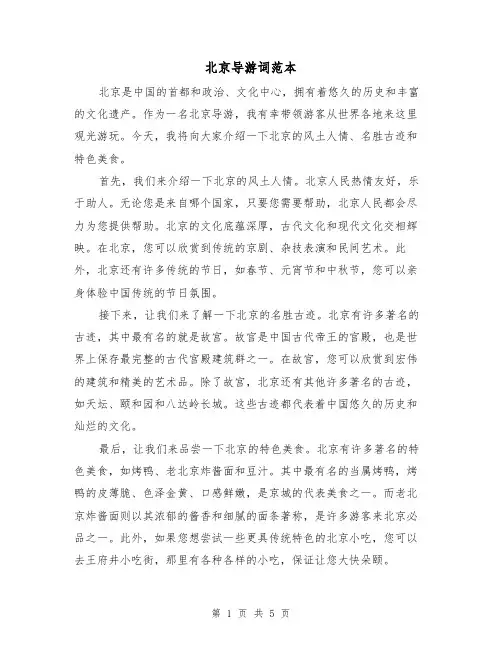
北京导游词范本北京是中国的首都和政治、文化中心,拥有着悠久的历史和丰富的文化遗产。
作为一名北京导游,我有幸带领游客从世界各地来这里观光游玩。
今天,我将向大家介绍一下北京的风土人情、名胜古迹和特色美食。
首先,我们来介绍一下北京的风土人情。
北京人民热情友好,乐于助人。
无论您是来自哪个国家,只要您需要帮助,北京人民都会尽力为您提供帮助。
北京的文化底蕴深厚,古代文化和现代文化交相辉映。
在北京,您可以欣赏到传统的京剧、杂技表演和民间艺术。
此外,北京还有许多传统的节日,如春节、元宵节和中秋节,您可以亲身体验中国传统的节日氛围。
接下来,让我们来了解一下北京的名胜古迹。
北京有许多著名的古迹,其中最有名的就是故宫。
故宫是中国古代帝王的宫殿,也是世界上保存最完整的古代宫殿建筑群之一。
在故宫,您可以欣赏到宏伟的建筑和精美的艺术品。
除了故宫,北京还有其他许多著名的古迹,如天坛、颐和园和八达岭长城。
这些古迹都代表着中国悠久的历史和灿烂的文化。
最后,让我们来品尝一下北京的特色美食。
北京有许多著名的特色美食,如烤鸭、老北京炸酱面和豆汁。
其中最有名的当属烤鸭,烤鸭的皮薄脆、色泽金黄、口感鲜嫩,是京城的代表美食之一。
而老北京炸酱面则以其浓郁的酱香和细腻的面条著称,是许多游客来北京必品之一。
此外,如果您想尝试一些更具传统特色的北京小吃,您可以去王府井小吃街,那里有各种各样的小吃,保证让您大快朵颐。
总之,北京是一个拥有丰富文化和悠久历史的城市。
作为一名北京导游,我将竭尽全力为游客提供优质的服务,让他们能够尽情欣赏北京的美景和美食。
欢迎大家来北京观光旅游,我相信您一定会留下美好的回忆。
谢谢!北京导游词范本(二)(____字)尊敬的各位游客,大家好!欢迎来到中国的首都——北京!作为一个多么有魅力和历史底蕴的城市,北京拥有许多令人叹为观止的景点和文化遗产。
今天,我将带领大家游览这座古老而现代的城市,与大家分享丰富的历史和令人印象深刻的故事。
北京导游词(精选15篇)
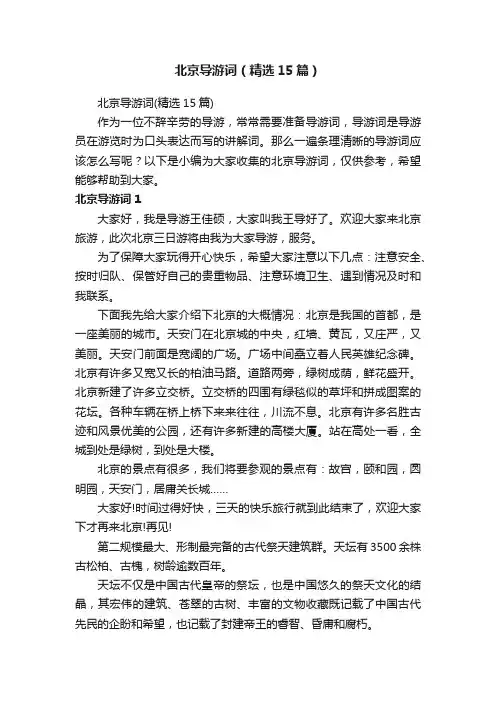
北京导游词(精选15篇)北京导游词(精选15篇)作为一位不辞辛劳的导游,常常需要准备导游词,导游词是导游员在游览时为口头表达而写的讲解词。
那么一遍条理清晰的导游词应该怎么写呢?以下是小编为大家收集的北京导游词,仅供参考,希望能够帮助到大家。
北京导游词1大家好,我是导游王佳硕,大家叫我王导好了。
欢迎大家来北京旅游,此次北京三日游将由我为大家导游,服务。
为了保障大家玩得开心快乐,希望大家注意以下几点:注意安全、按时归队、保管好自己的贵重物品、注意环境卫生、遇到情况及时和我联系。
下面我先给大家介绍下北京的大概情况:北京是我国的首都,是一座美丽的城市。
天安门在北京城的中央,红墙、黄瓦,又庄严,又美丽。
天安门前面是宽阔的广场。
广场中间矗立着人民英雄纪念碑。
北京有许多又宽又长的柏油马路。
道路两旁,绿树成荫,鲜花盛开。
北京新建了许多立交桥。
立交桥的四围有绿毯似的草坪和拼成图案的花坛。
各种车辆在桥上桥下来来往往,川流不息。
北京有许多名胜古迹和风景优美的公园,还有许多新建的高楼大厦。
站在高处一看,全城到处是绿树,到处是大楼。
北京的景点有很多,我们将要参观的景点有:故宫,颐和园,圆明园,天安门,居庸关长城……大家好!时间过得好快,三天的快乐旅行就到此结束了,欢迎大家下才再来北京!再见!第二规模最大、形制最完备的古代祭天建筑群。
天坛有3500余株古松柏、古槐,树龄逾数百年。
天坛不仅是中国古代皇帝的祭坛,也是中国悠久的祭天文化的结晶,其宏伟的建筑、苍翠的古树、丰富的文物收藏既记载了中国古代先民的企盼和希望,也记载了封建帝王的睿智、昏庸和腐朽。
各位亲爱的游客朋友们,我们今天的游览就要结束了。
非常高兴能与大家共同度过这段美好的时光。
对我今天的导游有什么不满意之处,请大家批评指正,谢谢!北京导游词2游客们,大家好!欢迎大家来到世界遗产——颐和园。
很高兴成为大家的导游,你们可以叫我小王。
今天我们来到颐和园,想必大家对颐和园里的景色都是充满了好奇和期待的。
北京导游词精选15篇
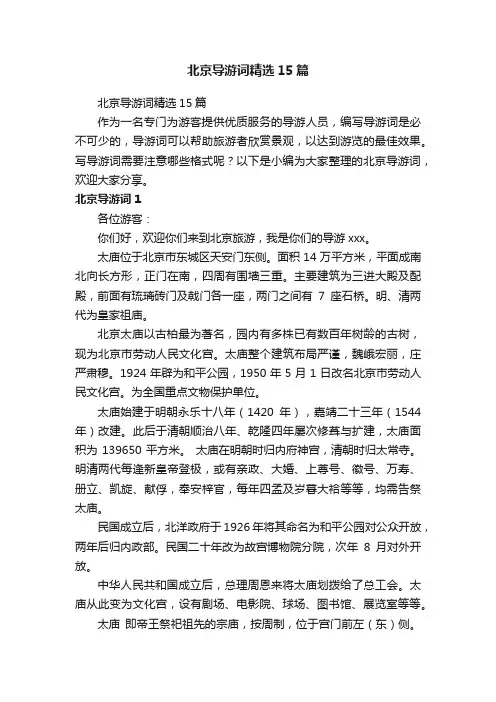
北京导游词精选15篇北京导游词精选15篇作为一名专门为游客提供优质服务的导游人员,编写导游词是必不可少的,导游词可以帮助旅游者欣赏景观,以达到游览的最佳效果。
写导游词需要注意哪些格式呢?以下是小编为大家整理的北京导游词,欢迎大家分享。
北京导游词1各位游客:你们好,欢迎你们来到北京旅游,我是你们的导游xxx。
太庙位于北京市东城区天安门东侧。
面积14万平方米,平面成南北向长方形,正门在南,四周有围墙三重。
主要建筑为三进大殿及配殿,前面有琉璃砖门及戟门各一座,两门之间有7座石桥。
明、清两代为皇家祖庙。
北京太庙以古柏最为著名,园内有多株已有数百年树龄的古树,现为北京市劳动人民文化宫。
太庙整个建筑布局严谨,魏峨宏丽,庄严肃穆。
1924年辟为和平公园,1950年5月1日改名北京市劳动人民文化宫。
为全国重点文物保护单位。
太庙始建于明朝永乐十八年(1420年),嘉靖二十三年(1544年)改建。
此后于清朝顺治八年、乾隆四年屡次修葺与扩建,太庙面积为139650平方米。
太庙在明朝时归内府神宫,清朝时归太常寺。
明清两代每逢新皇帝登极,或有亲政、大婚、上尊号、徽号、万寿、册立、凯旋、献俘,奉安梓官,每年四孟及岁暮大袷等等,均需告祭太庙。
民国成立后,北洋政府于1926年将其命名为和平公园对公众开放,两年后归内政部。
民国二十年改为故宫博物院分院,次年8月对外开放。
中华人民共和国成立后,总理周恩来将太庙划拨给了总工会。
太庙从此变为文化宫,设有剧场、电影院、球场、图书馆、展览室等等。
太庙即帝王祭祀祖先的宗庙,按周制,位于宫门前左(东)侧。
文献记载,古代宗庙,是每庙一主:唐夏五庙,商七庙,周亦七庙;汉代则不仅京城立庙,各郡国同时立庙,于是其数达一百七十六所,这是和后来天子宗庙仅太庙一处的制度很不相同的。
每庙一主变为一庙多室、每室一主的形制,大约是魏晋间事。
魏有四室,晋为七室,东晋增至十室至十四室,亲尽则祧迁。
原在庙内两厢别立夹室“储”贮放已祧神主,后世则另立祧庙于殿后。
北京旅游解说导游词(精选16篇)
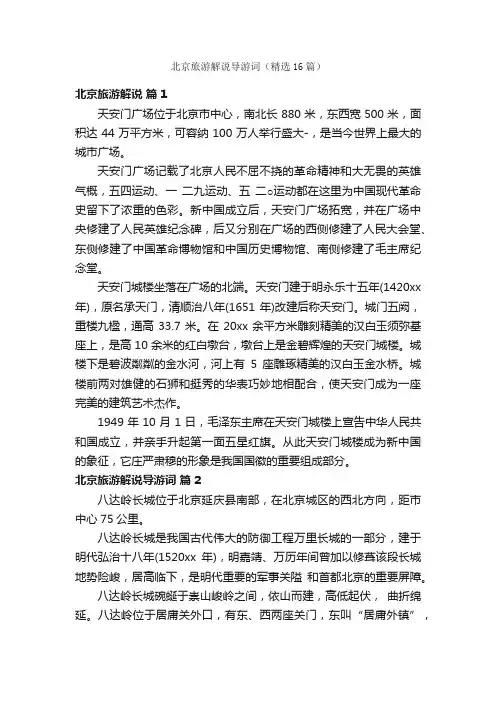
北京旅游解说导游词(精选16篇)北京旅游解说篇1天安门广场位于北京市中心,南北长880米,东西宽500米,面积达44万平方米,可容纳100万人举行盛大-,是当今世界上最大的城市广场。
天安门广场记载了北京人民不屈不挠的革命精神和大无畏的英雄气概,五四运动、一二九运动、五二○运动都在这里为中国现代革命史留下了浓重的色彩。
新中国成立后,天安门广场拓宽,并在广场中央修建了人民英雄纪念碑,后又分别在广场的西侧修建了人民大会堂、东侧修建了中国革命博物馆和中国历史博物馆、南侧修建了毛主席纪念堂。
天安门城楼坐落在广场的北端。
天安门建于明永乐十五年(1420xx 年),原名承天门,清顺治八年(1651年)改建后称天安门。
城门五阙,重楼九楹,通高33.7米。
在20xx余平方米雕刻精美的汉白玉须弥基座上,是高10余米的红白墩台,墩台上是金碧辉煌的天安门城楼。
城楼下是碧波粼粼的金水河,河上有5座雕琢精美的汉白玉金水桥。
城楼前两对雄健的石狮和挺秀的华表巧妙地相配合,使天安门成为一座完美的建筑艺术杰作。
1949年10月1日,毛泽东主席在天安门城楼上宣告中华人民共和国成立,并亲手升起第一面五星红旗。
从此天安门城楼成为新中国的象征,它庄严肃穆的形象是我国国徽的重要组成部分。
北京旅游解说导游词篇2八达岭长城位于北京延庆县南部,在北京城区的西北方向,距市中心75公里。
八达岭长城是我国古代伟大的防御工程万里长城的一部分,建于明代弘治十八年(1520xx年),明嘉靖、万历年间曾加以修葺该段长城地势险峻,居高临下,是明代重要的军事关隘和首都北京的重要屏障。
八达岭长城碗蜒于崇山峻岭之间,依山而建,高低起伏,曲折绵延。
八达岭位于居庸关外口,有东、西两座关门,东叫“居庸外镇”,西称“北门锁钥”。
关城东窄西宽,长城从“北门钥锁”关门城合台起依山而筑,城墙高低不一,平均高约7.5米,顶宽约6米,可容五马并驰,十人并行。
该段长城的墙体是用整齐巨大的条石铺成,有的条石长达2米,重数百斤。
游北京导游词简介范文(通用5篇)
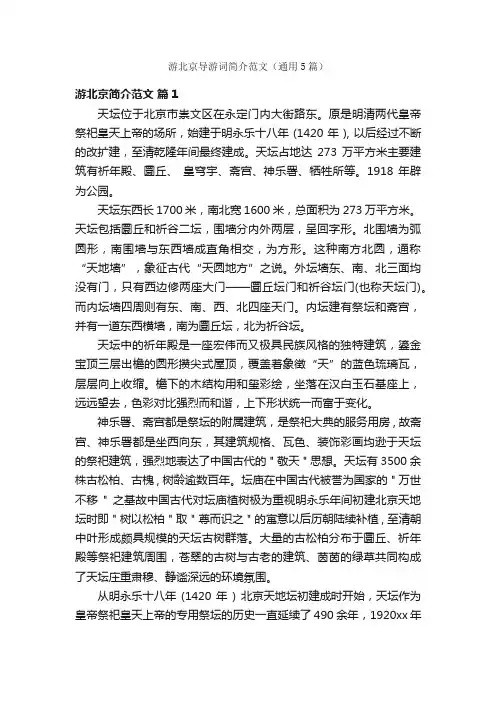
游北京导游词简介范文(通用5篇)游北京简介范文篇1天坛位于北京市崇文区在永定门内大街路东。
原是明清两代皇帝祭祀皇天上帝的场所,始建于明永乐十八年 (1420 年 ), 以后经过不断的改扩建,至清乾隆年间最终建成。
天坛占地达273 万平方米主要建筑有祈年殿、圜丘、皇穹宇、斋宫、神乐署、牺牲所等。
1918 年辟为公园。
天坛东西长1700米,南北宽1600米,总面积为273万平方米。
天坛包括圜丘和祈谷二坛,围墙分内外两层,呈回字形。
北围墙为弧圆形,南围墙与东西墙成直角相交,为方形。
这种南方北圆,通称“天地墙”,象征古代“天圆地方”之说。
外坛墙东、南、北三面均没有门,只有西边修两座大门——圜丘坛门和祈谷坛门(也称天坛门)。
而内坛墙四周则有东、南、西、北四座天门。
内坛建有祭坛和斋宫,并有一道东西横墙,南为圜丘坛,北为祈谷坛。
天坛中的祈年殿是一座宏伟而又极具民族风格的独特建筑,鎏金宝顶三层出檐的圆形攒尖式屋顶,覆盖着象徵“天”的蓝色琉璃瓦,层层向上收缩。
檐下的木结构用和玺彩绘,坐落在汉白玉石基座上,远远望去,色彩对比强烈而和谐,上下形状统一而富于变化。
神乐署、斋宫都是祭坛的附属建筑,是祭祀大典的服务用房 , 故斋宫、神乐署都是坐西向东,其建筑规格、瓦色、装饰彩画均逊于天坛的祭祀建筑,强烈地表达了中国古代的 " 敬天 " 思想。
天坛有 3500 余株古松柏、古槐 , 树龄逾数百年。
坛庙在中国古代被誉为国家的 " 万世不移" 之基故中国古代对坛庙植树极为重视明永乐年间初建北京天地坛时即 " 树以松柏 " 取 " 尊而识之 " 的寓意以后历朝陆续补植 , 至清朝中叶形成颇具规模的天坛古树群落。
大量的古松柏分布于圜丘、祈年殿等祭祀建筑周围,苍翠的古树与古老的建筑、茵茵的绿草共同构成了天坛庄重肃穆、静谧深远的环境氛围。
从明永乐十八年(1420 年) 北京天地坛初建成时开始,天坛作为皇帝祭祀皇天上帝的专用祭坛的历史一直延续了 490 余年,1920xx年爆发的辛亥革命结束了中国两千余年的封建帝制,也结束了贯穿中国历史达五千年的祭祀史,专用于为皇帝祭祀服务的天坛从此" 任人游览",1918 年民国政府将天坛辟为公园,实行售票开放。
介绍北京的导游词(精选15篇)
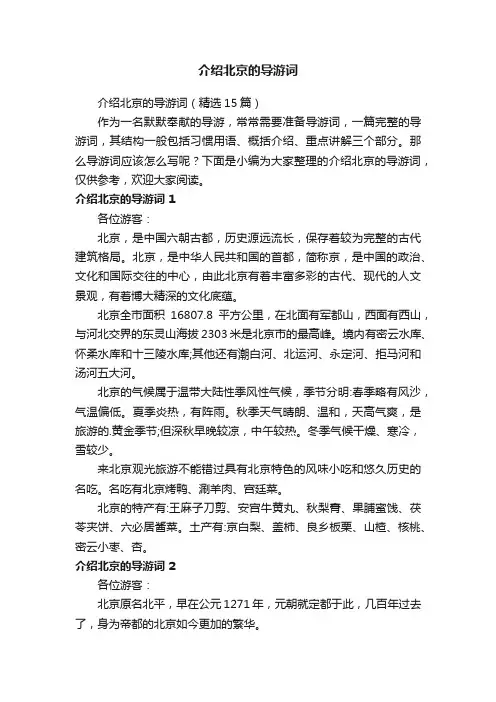
介绍北京的导游词介绍北京的导游词(精选15篇)作为一名默默奉献的导游,常常需要准备导游词,一篇完整的导游词,其结构一般包括习惯用语、概括介绍、重点讲解三个部分。
那么导游词应该怎么写呢?下面是小编为大家整理的介绍北京的导游词,仅供参考,欢迎大家阅读。
介绍北京的导游词 1各位游客:北京,是中国六朝古都,历史源远流长,保存着较为完整的古代建筑格局。
北京,是中华人民共和国的首都,简称京,是中国的政治、文化和国际交往的中心,由此北京有着丰富多彩的古代、现代的人文景观,有着博大精深的文化底蕴。
北京全市面积16807.8平方公里,在北面有军都山,西面有西山,与河北交界的东灵山海拔2303米是北京市的最高峰。
境内有密云水库、怀柔水库和十三陵水库;其他还有潮白河、北运河、永定河、拒马河和汤河五大河。
北京的气候属于温带大陆性季风性气候,季节分明:春季略有风沙,气温偏低。
夏季炎热,有阵雨。
秋季天气晴朗、温和,天高气爽,是旅游的.黄金季节;但深秋早晚较凉,中午较热。
冬季气候干燥、寒冷,雪较少。
来北京观光旅游不能错过具有北京特色的风味小吃和悠久历史的名吃。
名吃有北京烤鸭、涮羊肉、宫廷菜。
北京的特产有:王麻子刀剪、安宫牛黄丸、秋梨膏、果脯蜜饯、茯苓夹饼、六必居酱菜。
土产有:京白梨、盖柿、良乡板栗、山楂、核桃、密云小枣、杏。
介绍北京的导游词 2各位游客:北京原名北平,早在公元1271年,元朝就定都于此,几百年过去了,身为帝都的北京如今更加的繁华。
坐火车初次来来北京的人,都会觉得火车站很热闹,公交很便捷。
据说北京的公交是我国城市公交车车长最长的,公交线路最多的,但因为堵车是时经常的事,所以在北京出行坐公交并不是最佳的选择。
北京的地铁线贯通城市地下,多达十几条,还没有堵车的困扰,是绝大多数人首选的出行方式。
在北京,最不愁的就是玩。
北京的.景点很多,如天安门、长城、故宫、颐和园、香山、欢乐谷、动物园、雍和宫、恭王府、天坛、地坛、卢沟桥、中华世界坛、中央电视台新址,等等。
2023北京导游词(精选22篇)
2023北京导游词(精选22篇)2023北京篇1各位游客朋友:我们现在已经来到了天安门广场。
大家可以看一下,我们现在的位置是在天安门广场南北方向的中轴线上,距我们南面的人民英雄纪念碑大约有100米左右的距离。
我们今天在天安门广场游览的时间是30分钟。
大家向我这里聚一下,我先给大家简要介绍一下天安门广场的主要景观。
(手势,向北指)大家先向这边看。
(稍停顿,待游客目光集中于手指方向)我爱北京--天-安-门。
一会儿,我会向大家详细介绍天安门的的沧桑历史。
除了天安门城楼外,我还要向您介绍天安门前的金水桥、以及桥前的华表和石狮。
大家回一下头,您看到了,这就是庄严挺拔的人民英雄纪念碑了,随后我也将向您讲一讲她的故事。
纪念碑南边的建筑就是"毛主席纪念堂",我们今天的行程没有安排大家瞻仰毛主席遗容,如果您有意去的话,可以告诉我,我会尽量满足您的愿望。
天安门广场东侧的建筑是中国革命历史博物馆,这里陈列了大量珍贵的革命历史文物。
和她相对着的,(手势,向西指)西边的这座建筑,就是非常著名的"人民大会堂"。
关于她,一会儿我也会向您做详细介绍。
好好好,大家现在可以在广场上拍照留念。
拍照前我给大家提个醒,大家尽量避免站在这条中轴线上拍照,旗杆可能会影响您的拍摄效果。
另外,大家如果在纪念碑前拍照的话,建议您到纪念碑的那一侧去拍,在这边是逆光,会影响照片的效果。
给大家10分钟时间,拍完照请到这里集合,我在这里等大家.下面我首先为大家介绍一下天安门城楼。
天安门原为明清两代皇城的正门,始建于明永乐十五年(1417),最初叫做承天门,取"承天启运,受命于天"之意。
清顺治八年(1651年)重修而改名天安门,含"受命于天"和"安邦治民"的意思。
至今已有580多年的历史了,是全国重点文物保护单位。
天安门城楼,建筑在巨大条石砌成的须弥座式城台上,造型庄重浑厚,宏伟典雅,是中国传统建筑艺术的典型代表作之一。
北京导游词(通用21篇)
北京导游词(通用21篇)北京导游词 1各位游客好,欢迎大家来到北京故宫。
今天就由我给大家介绍这里的风景名胜。
请大家跟着我的脚步,我们面前的就是著名的'故宫博物院。
好,跨进这个大门,我们就来到故宫到廷三大殿中最大的一殿——太和殿,民间俗称“金銮殿”。
它建于明永乐十八年也就是1420年,清康熙三十四年就是1695年重建,大家猜猜太和殿高多少,面积多少呢?没错,它高35米左右,面积有2377平方米,差不多有55间教室那么大,由72根大柱支撑着全部重量,是故宫中最高大建筑。
你们瞧!里面装饰得金碧辉煌,正中间一个有宝座,宝座并置于6根盘龙金柱之间,以突出帝王唯我独尊的地位。
九龙宝座用楠木雕龙涂金而成,可精致了!大家一起向右走,前面就来到中和殿了。
中和殿的大殿平面呈方形,黄琉璃四有攒尖顶,可气派了!大家知道吗?那时皇帝就是在这里进行亲祭、批阅奏书的。
大家跟我一起往前走,这块空地上最显眼的就是云龙石雕。
这是故宫中最大的一座石雕。
石长16.57米,宽3.07米,厚1.7米,重达两百多吨呢!大家可以凑近看一看,石雕四周刻有缠枝莲花纹,下部为海水江涯,中间雕刻着流云衬托着九条蟠龙和州龙,云龙栩栩如生,雕刻精细。
今天的讲解到此结束,大家可以自行参观。
我想提醒大家:注意看到任何东西绝对不能用手触摸,以保护这珍奇的文物。
我们20分钟后在这里集合。
再见!祝大家玩得开心。
北京导游词 2游客们:大家好!欢迎大家来到世界遗产——黄山风景名胜区。
很高兴成为大家的导游!我叫XX,大家叫我王导好了。
俗话说:“五岳归来不看山,黄山归来不看岳。
”黄山以奇松、怪石、云海、温泉、冬雪“五绝”闻名中外。
这天我就给大家重点介绍黄山的奇松吧。
大家请看,黄山的松树能在岩石缝中生存,生命力极强。
它们形状各异,姿态万千:黑虎松、龙爪松、连理松、迎客松等很多松树都因为它们的形状而得名呢!迎客松是黄山著名的景点之一,外形更是个性:它的树干中部伸出长达7.6米的两大侧枝展向前方,恰似一位好客的主人,挥展双臂,热情欢迎海内外宾客来黄山游览,成为中华民族热情好客的.象征。
关于北京的导游词(精选15篇)
关于北京的导游词(精选15篇)关于北京的篇1各位游客们,我们现在来到的是世界上最大的城市中心广场,天-安-门广场,面积达到了44万平方米,而且北京在世界上的地理位置就是以广场的经纬度(东经:116°23′17〃,北纬:39°54′27〃)来确定的,北京导游词。
它坐落在北京市中心,一直注视着北京自古至今的历史变革。
在明代,这里曾叫做承天门广场,出现了t型广场,当然,现在已经没有了。
清代的时候才改为现在的天-安-门广常在辛亥革命以后,天-安-门广场成了最好的群众运动集结地,着名的五四运动,一二九学生运动等等就是在这里发生的。
而在这里最着名的事件,相信大家一定知道,那就是在1949.10.1的开国大典,当时这里聚集了30万人,共同来庆祝新中国的成立。
解放以后,将t型广场拆除,建了人民英雄纪念碑,人民大会堂和历史博物馆,革命博物馆等大型建筑。
而在76年,毛主席去世后,在原来中华门的位置上建立起了毛主席纪念堂,从而形成了广场今天的建筑格局。
而在国庆50周年的时候,天-安-门广场经历了一系列的整修,使广场更加美丽壮观整洁。
各位一定很向往我所描述的天-安-门广场,没有关系,在接下来的游览过程,我将向大家一一介绍。
明代永乐年间,这里叫做承天门,只是一个木牌坊,劝承天启运,受命于天”之意。
可是明代的时候被烧毁了,后来修建了面阔九间,进深五间的城楼,真正体现了帝王的之尊。
但是明朝末年,又被毁了。
而在清顺治年间,重修城楼以后,改名为天-安-门,将另外的三个皇城门儿都改名为带安字的,将故宫三大殿都改名为带和字的,体现了内和外安的美好愿望,这就是我们现在所看的城楼,它由城基、城台、城楼三个部分组成。
基座是汉白玉须弥座,这是我国古代最高等级的基座,高1.59米。
城台高14.6米。
而城楼重檐歇山顶,这也是当时殿宇屋顶的最高等级。
整座建筑高33.7米,在70年重修后,升高了一米。
这座建筑等级非常高的城楼,它的作用也同样非常重要。
介绍北京导游词(通用15篇)
介绍北京导游词(通用15篇)介绍北京篇1Hello, everyone. Have you ever been to Beijing?What's the weather like in Beijing?Beijing's cold weather is not to see the sun outside, what to see? Look atthe wind! As long as the wind blows, the weather will be relatively cold. What'sthe wind blowing in winter? What's the wind blowing in summer? The primaryschool teacher said that southeast wind blows in summer and northwest wind blowsin winter. Please remember. A student stood up and said: No, my mother said thatshe married my father and drank all year round You choose to come to Beijing at the end of October. Generally speaking,the time is very good. It's neither cold nor hot. It's an ideal tourist seasonin Beijing. As the saying goes: in good travel time, meeting a good guide is akind of happiness; in good travel time, meeting a poor guide is a kind ofsadness. It's a sigh to meet a good tour guide in a bad travel time; it's a kindof helplessness to meet a poor tour guide in a bad travel time. I hope we have agood time to travel, and I hope I am a good guide.I'd like to introduce myself. My family name is Li and my name is Tianyun.After you met me, I wish you good luck every day. Li is Muzi Li. You can call medirector Li, but don't call me director Li. You can also call me Xiao Li, butdon't add Zi. Xiao Li is Li Lianying, the eunuch next to Empress Dowager Cixi.Eunuch is an incomplete man. Besides being thin, the function of other parts ofhis body is quite normal. I was born on December 26. What's the specialsignificance of this day? My mother's birthday is also on this day, and myemperor Taizu's birthday is also on December 26. My emperor Taizu is ChairmanMao Zedong. I wantto have the same birthday as a great man. I can't be worse inmy life. But after living for more than 20 years, I found that I'm not tall, notshort, not fat, not thin, not old, not tender, and so on So far, no miracle hashappened to me, but it doesn't matter. As the saying goes, height is not thedistance, weight is not the pressure, age is not the problem, so I still have toconfidently take everyone's activities in Beijing these days.In addition to taking you on a tour, we also have a master in charge of ourtransportation. Our master has more than ten years of driving experience. Heusually receives deputies to the National People's Congress, and receives VIPguests and athletes during the Olympic Games. There has been no accident formore than ten years. He is very professional and safe. During our time inBeijing, we have master _ _ driving for us. We have to work hard for him in thenext few days. Let's give him some applause first!Although the roads in Beijing are very broad now, Beijing, as the capital,has many people and cars, and the traffic condition is not very good most of thetime. During our travel time, there may be traffic jams or people waiting forthe bus. I hope you can understand.People live on food. When they come to Beijing, the first thing they shouldpay attention to is eating. When they come out, they won't be as comfortable asthey are at home. Especially when they join a tour group, they should beprepared: the tour group meal in Beijing is very bad. What is despair? Despairis two dishes served in a restaurant, Eat the first one: "is there anythingworse in the world?" eat the second one "Kao! It's really there!" although thegroup meal is bad, it's still quite hygienic. You can rest assured to eat it.The principle is to have enough food, eight dishes and one soup, and all therice. When you see that the foodis not enough, drink the soup quickly. If wedon't have enough to eat, we can see the mountains far away and have a pot ofsteamed bread. If you come back to China for tourism in the future, if thenumber of people is small, you should try not to arrange group meals by travelagencies. You'd better have what you want (for Hong Kong and overseasChinese).Next is the accommodation. Beijing is the capital, the political andcultural center. People come and go very frequently, so hotels of the same levelin Beijing are not as good as those in other places. Then it gives a briefintroduction of the hotel (such as stars, how far to the airport, how far to therailway station, how far to Tiananmen Square). In the evening, when we go backto the hotel, we should pay attention to rest. When we go shopping, we are notfamiliar with the place, so we should not go too far. The three things you mustdo when you come to Beijing are climbing the Great Wall, eating roast duck andwatching acrobatics. I think we have arranged to climb the great wall and eatroast duck in our itinerary, but we haven't arranged to watch acrobatics. I'mvery sorry. About in the Neolithic age, Chinese acrobatics had sprouted. Soacrobatics has a history of more than 20__ years in China. Diving, rings andother sports in our Olympic Games are all evolved from acrobatics. Trampoline,which was officially an Olympic event in 20__, is also evolved from acrobatics.China's trampoline won two Olympic gold medals in 20__ Beijing Olympic Games.Chinese people can be proud to announce to the world that we can't do football,we can't do track and field, we can't do swimming pool, but we can't do it inbed! Chaoyang theater is the only designated theater for external performance inBeijing. During the Olympic Games, all foreign leaders came to China to watchacrobatic performances. Modern acrobaticscombined with sound, color, light andother advanced elements are more gorgeous and exciting than traditionalacrobatics. It really reflects the brilliance of one minute on stage and tenyears off stage. Almost all the performances have won awards in theinternational arena, so we are visiting Beijing During this period, acrobaticsis absolutely not to be missed if you have time in the evening. If you don't go,you will be sorry, but you will be shocked.The most important thing to come to Beijing is to visit. Apart fromclimbing the Great Wall, eating roast duck and watching acrobatics, what elsecan we play? Generally speaking, we can enter Guangzhou to watch cars, fly toGuilin to watch mountains, go to Xi'an to watch tombs, visit Beijing to watchwalls, pass Tianjin to watch docks, visit Qinghai to watch the source, visitTibet to watch Buddha's head, visit Nanjing to watch stones, visit Shanghai towatch people's heads drunk, visit Shanghai to watch people's heads;Unforgettable Hangzhou girl. What you see in Beijing is the top of the wall,that is, the most important thing is the history and culture left over from theancient capital. If you join this tour group and meet guide Xiao Li, you are ina Beijing history and culture crash course, so you should listen to mecarefully. Can't get on the car to sleep, get off the car to pee, take photos ofscenic spots, go home and ask nothing. Especially when there are many touristsin Beijing, adults look at their heads and children look at their buttocks, sowe should play with me, hold the hand of the guide, and travel together inBeijing!Beijing is the capital of Liao, Jin, yuan, Ming and Qing Dynasties, thelast five feudal dynasties in Chinese history. Its design and planning embodiesthe highest achievement of ancient Chinese urban planning, and is known as "thegreatestindividual project of human beings on the surface of the earth". Weshould not only look at the history, but also the modern development of Beijing.Now let's briefly introduce the situation of Beijing.Beijing covers a total area of 16808 square kilometers and is divided into18 districts. Beijing is surrounded by Hebei Province. From the map, HebeiProvince surrounds the whole of Beijing, and it is not far from BeijingChengde Mountain Resort is the largest classical Royal Garden in China. In1984, it was rated as one of the top ten scenic spots in China. In 1994, it waslisted in the world heritage list. It is very worth seeing. If we can arrange itsometimes, we should go there for a day or two.The terrain of Beijing is high in the northwest and low in the southeast,which is in line with the artistic conception of an ancient poem that a riverflows eastward. Beijing plain accounts for 1 / 3, mountain accounts for 2 / 3.There are more than 16 million permanent residents in Beijing, more than 4million people from other places, and more than 20 million people live in onethird of the plain. Therefore, the traffic pressure just mentioned is veryheavy.To this end, Beijing has made great efforts to improve the trafficenvironment. The cost of bus is also very cheap. Basically, one yuan is enoughfor taking the bus, and 20% or 40% discount can be given for those with buscard. We work in the suburbs because it's expensive to rent or buy a house inthe urban area. Although it's cheap to take the bus, it takes a long time. Weneed to get up early in the morning to go to work. Sometimes it only takes 30minutes to do a business in the urban area, but it takes two hours to come bybus, and it takes two hours to go back, soone day is spent on the bus. Becauseof the long journey, we usually have to take the bus home from work, so thenightlife in Beijing is not very rich. Talk about the four idiots in Beijing:eat lobster, go shopping to Yansha, sing and love flowers, and go home afterwork. The poor go home after work, the drunkard go home at 9, the luster go homeat 11 and the gambler go home at 2-3.The starting price of a taxi is 10 yuan for 3 km, and 2 yuan per km after 3km. In addition to improving the above ground transportation, we should focus onthe development of the subway. The cost of the subway is also very cheap. Itcosts 2 yuan to get through. As long as you don't go out of the subway door, youcan take a ride for a day, so as to stimulate the reduction of private cars,reduce road congestion, improve air quality and environmental protection. Butthe rich should buy a car or buy a car, and the poor should take what kind ofcar, so we should not climb, compare, and be angry with ourselves in our dailylife; eat less salt, be jealous, play less mahjong, and take more walks; sleepon time, get up on time, and do boxing and aerobics.Good health is really good. According to official statistics, the averagelife span of Beijingers has reached 80 years old. Before the reform and openingup, it was 60 years old. Why? With the improvement of living standards, Chinesesociety is developing, and Beijing is developing. In the past, only the emperorcan eat, but now ordinary people can also eat the palace flavor. In the past,the emperor can wear silk, but now ordinary people can buy it, too The jadebrought by the emperor is good for our health. We can also buy it now. Themedicinal materials of T ongrentang, which has a history of more than 300 years,used to be used exclusively by the royal family, especially the EmpressDowagerCixi, who used to take the Wuji Baifeng pill of Tongrentang all the year round.Now we can also buy it. We can also buy the Royal Cloisonne ornaments. In short,the royal family can eat, wear and play Good health, we can do now, in additionto the emperor's harem three thousand, so many women we can't do. When we cometo Beijing for tourism, if we need to use these things or give them as gifts tofriends and relatives, they are very helpful. They can support the developmentof Beijing's tourism industry and improve our taste in life. When it comes totaste, men are divided into six grades: first-class men have a home outsidetheir home, second-class men have flowers outside their home, third-class menfind a home in their flowers, fourth-class men go home from work, fifth classmen go home from work, and their wives are not at home, sixth class men go homefrom work, and there is a man beside their wives. Women can be divided into fourclasses. First class beauties travel abroad, second class beauties ShenzhenZhuhai, third class beauties Beijing Shanghai, and fourth class beauties wait athome.So what do we usually call a beautiful woman in Beijing? The older one iscalled sister, the older one is called aunt, and the younger one is called girl.Generally speaking, men are called elder brother, and the elderly are calledelder brother. Children are called children. But pure Beijingers, that is, oldBeijing, call girls girls girls instead of girls. I don't call a beauty abeauty, but a honey. Call him or not, call him ya. I don't care if you call meinside. Call a woman a woman, not a woman. Call a man a man, not a man. Call afriend porcelain instead of a friend. A lover is not called a lover, but an ace.I don't call a little girl a little girl, but a girl.This is Beijing's address, Tianjin's address is more special, forexample:there are people calling sister, not sister, anyway, no matter how old you are,even if you are only a teenager, there may be 50 or 60 years old people callingyour sister, not sister. There are those who call big brother, but not brothersor brothers. Even an elderly grandmother will call a young man in her 20s bigbrother, but she won't call brothers. Some call uncle, but not uncle. That is tosay, no matter what is your father's ranking at home, you should call his otherbrothers uncle, and your father's younger brother is not uncle. In a word, it'sbasically shouting. That's what Tianjin is called. Tianjin is called the backgarden of Beijing. During holidays, Beijingers will drive there for holidays.Tianjin is more than 100 kilometers away from Beijing, and the whole journey isonly two hours to Tianjin. If we have time, we can play one more city by the waywith little fare.The road we are taking now is the capital airport expressway, which wasbuilt in 92 and opened to traffic in 93. The capital airport expressway is 18 kmlong, with 34.5 m wide subgrade and 6 lanes in both directions. There are 3 mwide emergency parking belts on both sides of the road. It is fully closed andinterchange. The design speed is 120 km / h. The starting point is Sanyuanqiao.It takes 10 minutes from Sanyuanqiao to the Capital International Airport.Expressway pavement structure layer, the introduction of foreign asphaltmodification technology, in the ordinary asphalt mixed with plastic or rubber,change the high temperature and low temperature stability of asphalt, make itnot soften at 60 ℃ high temperature, not brittle at minus 30 ℃ low temperature,but also enhance the anti-wear ability, reduce noise, greatly extend the servicelife. The use of modified asphalt, which is the first in domestic highwayconstruction. The capital airport expressway costs 100 million yuan perkilometer, which is knownas the first road to China. No matter how old anofficial or ordinary person you are, you have to enter Beijing from thisexpressway.Usually when we talk about Beijing, where is it called Beijing? Accordingto the official regulations, the third ring road is called Beijing. Sanyuanqiao,the starting point of our airport expressway, connects the third ring road. Whatis "three yuan"? The imperial examination system is called "three yuan". Thefirst place of the provincial examination, the imperial examination and theimperial examination is Jieyuan, Huiyuan and the number one scholar. One afteranother, he won the first place in the provincial examination, the generalexamination and the palace examination, which is called Lianzhong Sanyuan.Taking the Qing Dynasty as an example, the whole process of imperial examinationin the old days started from the grass-roots level of government, prefecture andcounty, which was called children's examination. Those who enter for theexamination are called Tong Sheng, and those who pass the examination are calledXiucai. The first one is called desk. The formal higher level nationalexamination is called the local examination, which is held in the provincialcapital. The examinees are scholars from all over the country. After passing theexamination, they are called Juren, and the first place is "Jieyuan"; the nexthigher level is the joint examination, which is held in the Ministry of rites.The examinees are Juren, and after passing the examination, they are calledGongsheng, and the first place is "Huiyuan"; The imperial examination was heldin the palace. The emperor personally presided over the examination. Thecandidates were Gongsheng, who were called Jinshi after winning the examination.The imperial examination system in ancient China has a history ofmore than onethousand years, in which 17 people were able to connect the three yuan.介绍北京导游词篇2Dear tourists, we are now here to Tiananmen Square, the largest city centersquare in the world, with an area of 440000 square meters. Moreover, thegeographical location of Beijing in the world is determined by the longitude andlatitude of the square (east longitude: 116 ° 23 ′ 17 ″, north latitude: 39 ° 54′ 27 ″),. It is located in the center of Beijing and has been watching thehistorical changes of Beijing since ancient times. In the Ming Dynasty, it wasonce called chengtianmen square. There was a T-shaped square. Of course, it isno longer there. In the Qing Dynasty, it was changed to Tiananmen Square. Afterthe revolution of 1911, Tiananmen Square became the best gathering place formass movements. The famous May 4th movement, the 129 student movement and so ontook place here. The most famous event here, I believe you all know, was thefounding ceremony on October 1, 1949, when 300000 people gathered here tocelebrate the founding of new China. After liberation, the T-shaped square wasdemolished and large buildings such as the monument to the people's heroes, theGreat Hall of the people, the history museum and the revolutionary museum werebuilt. In 1976, after the death of the president, the memorial hall of thepresident was built on the original position of the Chinese gate, thus formingthe architectural pattern of the square today. In the 50th anniversary of thenational day, Tiananmen Square has undergone a series of renovation, making thesquare more beautiful, spectacular and clean. You must be looking forward to theTiananmen Square I described. It doesn't matter. I will introduce it to you oneby one in the next tour.During the Yongle period of the Ming Dynasty, it was called Chengtian gate.It was just a wooden archway, which means "to carry out the transportation fromheaven, to be ordered by heaven". However, it was burned down in the MingDynasty. Later, the city building with nine wide faces and five deep faces wasbuilt, which truly reflected the emperor's respect of 95. But at the end of MingDynasty, it was destroyed again. During the reign of emperor Shunzhi of the QingDynasty, after the reconstruction of the city tower, it was renamed Tian'anmen,the other three imperial city gates were renamed dai'an, and the three mainhalls of the Forbidden City were renamed dai'he, which reflected the good wishesof internal and external security. This is what we are looking at now. It iscomposed of three parts: the foundation, the platform and the tower. The base iswhite marble xumizuo, which is the highest level base in ancient China, with aheight of 1.59 meters. The platform is 14.6 meters high. And the double eaves ofthe city tower rest on the top of the mountain, which was also the highest levelof the temple roof at that time. The whole building is 33.7 meters high. After70 years of renovation, it has risen by one meter.This is a very high-grade building, and its role is also very important. Inthe Ming and Qing Dynasties, whenever there was a national ceremony, theceremony of "Jinfeng imperial edict" was held on the city tower. After theimperial edict was announced, a wood carved Golden Phoenix was put on the yellowsilk thread machine. The Golden Phoenix carried the imperial edict down thewall. The officials of the Ministry of rites caught it with a cloud tray, andthen put it into the Dragon Pavilion to praise the Ministry of rites, and thenpromulgated it. )And whenever the emperor went out of the palace to sacrifice,this was the only way.The most important moment for new China was also bornhere. The chairman solemnly announced the founding of new China on the TiananmenGate Tower, and personally angered the first five-star red flag of new China.The portrait of the chairman on the city floor is replaced every year before thenational day.The river in front of Tiananmen tower is called Jinshui River. Then why isit called Jinshui River? Because this river is drawn from the northwest ofBeijing, and in the Yin Yang and five elements, the West belongs to Jin and theNorth belongs to water, so this river is named Jinshui River, and the sevenwhite jade bridges on the river are Jinshui bridge. The two bridges next to themare called Gongsheng bridge, which correspond to the Taimiao temple and thesheji altar, which are now the Cultural Palace of the working people andZhongshan Park. The one in the middle is the royal road bridge, which isspecially used by the emperor and queen. The two bridges beside it are royalbridges, which are used by the royal princes. The two bridges beside them aregrade bridges, which can only be passed by officials above grade three.In front of Jinshui bridge, there is a stone lion on the left and right.The one on the left is the master, and the one on the right is the lioness. Howcan we tell the male from the female? Because the male master's foot is on thehydrangea, while the female lion is the cub. Now in order to protect thecultural relics, the lions have been fenced up. There were a pair of Huabiaobefore and after Tiananmen Square. In fact, the original name of Huabiao was FeiMu. It was set up by the emperor to show that he could accept and acceptopinions, and gradually evolved into today's Huabiao. The monster at the top ofit is called Hou. The one on the North China watch is called wangjunchu, whichmeans to let the emperor go out of the palace to observe the people'sfeelings.The one on the south end is called wangjungui, which means that the emperorshould not be nostalgic for the world outside the Palace, but should go back tothe palace in time to deal with government affairs.Now please turn back. Behind us is Tiananmen Square. In the Ming and QingDynasties, it was T-shaped, with a north-south royal road in the middle. On bothsides of the royal road, there were Qianbu corridor, with 110 corridors on bothsides. On the south side of Chang'an Street, with the red wall extending to theEast and West, there were 34 corridors, so Qianbu corridor had 228 corridors. Atthe southernmost end of the imperial Road, damingmen was in the Ming Dynasty,but it was changed to daqingmen in the Qing Dynasty; The gates on the East andwest sides are Chang'an left gate and Chang'an right gate, which are also calledLongmen and Humen respectively. After the scientific examination, Huang Bangannounced in the left gate of Chang'an that the Jinshi in the examination wouldenter the imperial city from here, so they are called Longmen. The reason forHumen is that after the frost falls every year, the imperial court has toexamine the prisoners, and the prisoners who are examined and approved are takenout of the right gate of Chang'an, which is tantamount to falling into thepalace Hukou is called Humen. These are all related to the five elements.In ancient China, there was a saying of "wendongwuxi", so on the East andwest sides of qianbulang is the location of Wufu Liubu. On the east side of thesquare, the area around the present history museum is basically the centralcivilian organs, while on the west side, that is, the area around the Great Hallof the people, are the five army governor's office and the secret service royalguards. In order to facilitate these officials to enter theImperial City, anorth-south gate, donggongsheng gate and xigongsheng gate, were built outsideLongmen Humen.Now we can't see the trace of that time. Instead, we have modern buildingswith more historical significance and political characteristics.On the west side of the square is the Great Hall of the people. It startedconstruction in October 1958 and lasted for one year. It was completed beforethe National Day in 1958, covering an area of 171800 square meters. The wholebuilding is like a "mountain". The highest point in the center is 46.5 meters,which is the highest building in Tiananmen Square. The great hall is dividedinto three parts: in the center is the auditorium of the ten thousand people'sCongress, with a total area of 36000 square meters and 10000 seats. There is ahuge red five pointed star on the top of the auditorium, giving off 70 to 70rays of light. The decoration layout of the whole dome is not only magnificent,but also a symbol of the unity of the people around the Party Central Committee;in the north is the banquet hall, with a total area of more than 7000 squaremeters, which is the largest banquet hall in China; In the south is the officebuilding of the National People's Congress, which includes the conference hallsof 37 provinces, autonomous regions, municipalities directly under the centralgovernment, such as Chongqing hall, Hong Kong hall, etc.In the northeast of the square is the Museum of the Chinese revolution,which was officially opened to the public on July 1, 61. The main exhibits arerevolutionary materials since the May 4th movement, and the contents of theexhibits in the museum are extremely rich. Southeast of the square is theChinese history museum. Its predecessor is the Beijing History Museum. In 26, itwas changed into the National History Museum. Four years later,it was changedinto the Beiping History Museum of Academia Sinica. In April 34, it was changedinto the Preparatory Office of the Central Museum and the Beiping HistoryMuseum. Its exhibits cover more than 300000 pieces of cultural relics, coins,pictures, etc. with thousands of years of history from the slavery society ofXia, Shang and Zhou Dynasties to the end of Qing Dynasty.Facing the Tiananmen Gate Tower is the monument to the people's heroes.According to the resolution of the first plenary session of the Chinese people'sPolitical Consultative Conference in September 49, the monument to the people'sheroes was built in Tiananmen Square. More than 240 design schemes werecollected from the whole country, and three schemes were selected. Finally, itwas decided that Liang Sicheng's design scheme should be taken as the main one,and the other three schemes should be integrated. That's what we see today.52.8.1 was officially built, completed in 58.4 and ceremoniously unveiled in5.1. The 100 ton core stone was transported from Qingdao to Beijing. After aseries of processing and carving, the finished product is 14.7 meters high, 2.9meters wide, 1 meter thick and weighs 60 tons. The body of the stone is composedof 413 pieces of granite. The base of the stele is composed of more than 17000pieces of granite and white marble, covering an area of more than 3000 squaremeters.The front of the monument faces Tiananmen Square and is inlaid with goldplate. The chairman wrote "the people's heroes are immortal". On the back is a158 character inscription drafted by the chairman and written by Premier Zhou(over the past three years, the people's heroes who died in the people'sLiberation War and the people's revolution are immortal) Over the past 30 years,the people's heroes who died in the people's Liberation Warand the people'srevolution are immortal, which dates back to 1840 years. Since then, in order tofight against internal and external enemies, strive for national independenceand people's freedom and happiness, the people's heroes who died in previousstruggles are immortal. There are eight reliefs around the pedestal, 2 metershigh and 40.68 meters long. From the East, the order is: Humen tobacco, thedestructed opium, the Wuchang movement, the 54 Movement, the May 30 movement,the Nanchang uprising, the Anti Japanese War, and the victory across the river.On both sides of the victory crossing, there are two decorative patterns, whichare: supporting the front line and welcoming the people's Liberation Army. Thereare 180 characters in all the reliefs.To the south of the monument to the people's Heroes is the chairman'smemorial hall. The construction of the memorial hall started on November 24,1976, and it took only six months to complete. Officially opened on the firstanniversary of the chairman's death. In front of the north gate of the memorialhall are two groups of clay sculptures, both of which are based on revolutionaryepics. The South Gate of the main building is to inherit the will of thepresident and show the confidence of the people of all ethnic groups. The 30 redflags outside the South Gate represent 30 provinces and autonomous regions inChina. The platform foundation of the memorial hall is built with jujube redgranite from the Dadu River. Around the foundation stone are stones from MountEverest and water from the Chinese Taiwan Strait. The main building of the memorial hallis composed of three parts: one enters the stele hall, facing a three meter highstatue of the chairman, where commemorative activities are held; one enters fromthe golden Phoebe gate on the south side。
- 1、下载文档前请自行甄别文档内容的完整性,平台不提供额外的编辑、内容补充、找答案等附加服务。
- 2、"仅部分预览"的文档,不可在线预览部分如存在完整性等问题,可反馈申请退款(可完整预览的文档不适用该条件!)。
- 3、如文档侵犯您的权益,请联系客服反馈,我们会尽快为您处理(人工客服工作时间:9:00-18:30)。
介绍北京的导游词文档4篇Introduction to guide words in Beijing编订:JinTai College介绍北京的导游词文档4篇前言:导游词是导游人员引导游客观光游览时的讲解词,是导游员同游客交流思想,向游客传播文化知识的工具,也是应用写作研究的文体之一。
本文档根据导游词内容要求和针对旅游地点是北京的特点展开说明,具有实践指导意义,便于学习和使用,本文下载后内容可随意调整修改及打印。
本文简要目录如下:【下载该文档后使用Word打开,按住键盘Ctrl键且鼠标单击目录内容即可跳转到对应篇章】1、篇章1:八达岭长城导游词文档2、篇章2:卢沟桥导游词文档3、篇章3:颐和园导游词文档4、篇章4:介绍故宫的导游词范文北京历史悠久,文化灿烂,是首批国家历史文化名城、中国四大古都之一和世界上拥有世界文化遗产数最多的城市。
下面是小泰为大家整理的介绍北京的导游词,欢迎参考!篇章1:八达岭长城导游词文档八达岭长城位于北京延庆县南部,在北京城区的西北方向,距市中心75公里。
八达岭长城是我国古代伟大的防御工程万里长城的一部分,建于明代弘治十八年(1520xx年),明嘉靖、万历年间曾加以修葺该段长城地势险峻,居高临下,是明代重要的军事关隘和首都北京的重要屏障。
八达岭长城碗蜒于崇山峻岭之间,依山而建,高低起伏,曲折绵延。
八达岭位于居庸关外口,有东、西两座关门,东叫“居庸外镇”,西称“北门锁钥”。
关城东窄西宽,长城从“北门钥锁”关门城合台起依山而筑,城墙高低不一,平均高约7.5米,顶宽约6米,可容五马并驰,十人并行。
该段长城的墙体是用整齐巨大的条石铺成,有的条石长达2米,重数百斤。
内部填满泥土和石块,墙顶地面铺满方砖,十分平整。
墙顶外侧筑有高 1.7米的垛口,上有了望孔,下有射击洞,内侧建有宇墙。
城墙每隔一段,筑有一个堡垒式的方形城台。
城台有高有低,高的叫敌搂,是守望和军士住宿的地方;低的叫墙台,高度与城墙相差不多但突出墙外,四周有垛口,是巡逻放哨的地方。
在制高点上还设有烟墩,即烽火台,是古代传递警讯的设施。
从1995年10月1日起,每个周末八达岭长城从南至北四烽火台的1200米距离内,650盏彩色泛光灯同时亮起迷人的灯光。
每日晚上18点30分至21点30分,对游人开放。
万里长城,人类的巨著!中华之魂!八达岭长城史称天下九塞之一,是万里长城的精华和杰出代表。
八达岭长城是万里长城向游人开放最早的地段,八达岭景区以八达岭长城为主,兴建了八达岭饭店、全周影院和由-主席亲笔题名的中国长城博物馆等功能齐全的现代化旅游服务设施,被评为中国旅游胜地四十佳之首和北京旅游的"世界之最"。
作为"世界文化遗产",八达岭景区以其宏伟的景观、完善的设施和深厚的文化历史内涵而著称于世。
八达岭地理环境优越,自古以来就是通往山西、内蒙、张家口的交通要道。
98年,八达岭高速公路建成通车,交通十分便利。
而且,八达岭的年平均气温比北京低3 ℃以上,成为"夏都"延庆的旅游龙头。
迄今,八达岭长城已接待中外游客1.2亿多人次,370多位外国元首及世界风云人物在此留下足迹。
篇章2:卢沟桥导游词文档【按住Ctrl键点此返回目录】永定河上的卢沟桥,在北京附近,修建于公元1189到1192年间。
桥长265米,整座桥由11个半圆形的石拱组成。
每个石拱长度不一,短的只有16米,长的有21.6米。
石拱之间有石桥墩,把11个桥拱连成一个整体。
由于各拱相连,所以卢沟桥叫做连拱石桥。
永定河发大水时来势很猛,以前两岸河堤常被冲毁,但是自从建成卢沟桥,再没有出过事,从这里可以看出它的设计很科学。
桥宽约8米,路面平坦,几乎与河面平行。
桥面用石板铺砌,两旁有石栏石柱。
每个柱头上都雕刻着不同姿态的狮子。
有的母子相抵,有的相互戏耍,有的像倾听水声,有的像检阅桥上的车马,千姿百态,栩栩如生。
早在13世纪,卢沟桥就闻名于世界。
那时候马可·波罗来过中国,他在游记里赞扬这座桥,说它是“世界上独一无二”的。
他特别欣赏柱子上的狮子,说它是“美丽的奇观”。
在国内,这座桥也历来为人们所称赞。
在我国人民抵抗帝国主义侵略战争的历史上,卢沟桥是值得纪念的。
1937年7月7日,爱-民奋起抗战,揭开了抗日战争的序幕,在中国历史上写下了光辉的一页。
篇章3:颐和园导游词文档【按住Ctrl键点此返回目录】颐和园是中国现存规模最大、保存最完整的皇家园林,中国四大名园(另三座为承德避暑山庄、苏州拙政园、苏州留园)之一。
位于北京市海淀区,距北京城区十五公里,占地约二百九十公顷。
利用昆明湖、万寿山为基址,以杭州西湖风景为蓝本,汲取江南园林的某些设计手法和意境而建成的一座大型天然山水园,也是保存得最完整的一座皇家行宫御苑,被誉为皇家园林博物馆。
颐和园(Summer Palace)原是清朝帝王的行宫和花园,前身清漪园,为三山五园(三山是指万寿山、香山和玉泉山。
三座山上分别建有三园清漪园、静宜园、静明园,此外还有附近的畅春园和圆明园,统称五园)中最后兴建的一座园林,始建于1750年,1764年建成,面积290公顷,水面约占四分之三。
乾隆继位以前,在北京西郊一带,已建起了四座大型皇家园林,从海淀到香山这四座园林自成体系,相互间缺乏有机的联系,中间的“瓮山泊”成了一片空旷地带。
乾隆十五年(1750年),乾隆皇帝为孝敬其母孝圣皇后动用448万两白银在这里改建为清漪园,以此为中心把两边的四个园子连成一体,形成了从现清华园到香山长达二十公里的皇家园林区。
咸丰十年(1860年),清漪园被英法联军焚毁。
光绪十四年(1888年),慈禧太后以筹措海军经费的名义动用银两(据专家考证,应为500至600万两白银),由样式雷的第七代传人雷廷昌主持重建,改称颐和园,作消夏游乐地。
到光绪二十六年(1920xx年),颐和园又遭“八国联军”的破坏,许多珍宝被劫掠一空。
光绪二十九年(1920xx年)修复。
后来在军阀混战、-统治时期,又遭破坏,1949年之后政府不断拨款修缮,1961年3月4日,颐和园被公布为第一批全国重点文物保护单位,1998年11月被列入《世界遗产名录》。
20xx年5月8日,颐和园经国家旅游局正式批准为国家5A级旅游景区。
20xx年,颐和园入选中国世界纪录协会中国现存最大的皇家园林。
颐和园拥有多项世界之最、中国之最。
篇章4:介绍故宫的导游词范文【按住Ctrl键点此返回目录】故宫相信很多的朋友都想要去游玩,那么介绍故宫的导游词怎么写呢?下面小泰就和大家分享介绍故宫的导游词,来欣赏一下吧。
介绍故宫的导游词(一)大家好!很欢迎大家前来游玩!我是xx,大家可以叫我x 导。
故宫清洁卫生有大家保持,请大家“高抬贵手”,不要乱扔果皮纸屑等垃圾。
一会儿下车的时候,大家一定要记住车牌号。
各位朋友、女士、先生和父老乡亲们,过一会我们将要参观故宫博物馆,我先为各位做的简介。
故宫是世界上现存范围最大的古代皇家宫殿建筑群。
故宫也叫紫禁城,“紫”是天上君王居住宫殿的颜色,那么,人间的帝王当然要与“紫”字沾边。
“禁”是指当时那里守卫森严,不要说是普通老百姓,即使是一品大员没有皇帝的召见也不能私自入城,否则就会引来杀身之祸。
故宫平面呈长方形,南北长960米,东西宽750米,总面积有72万平方万米。
整座紫禁城被宽52米的护城河所环绕,城墙高10米,可谓是“城高池宽”。
故宫开四门,座北朝南,南门为午门,即正门,北门为神武门,东为东华门,西为西华门。
故宫的整个院落分为二大部分,即“前朝”和“后寝”。
“前朝”是皇帝举行盛大典礼的地方,以太和殿、中和殿、保和殿及东西两侧的文华殿及武英殿为主。
“后寝”是皇帝及后妃居住的地方,交秦殿、坤宁宫及东西六宫为主。
除此之外、故宫内还有很多其他各式各样用途不一的大小宫殿。
据说当年紫禁城共有宫殿九千九百九十九半间,够多吧?打个比方说吧,如果一个婴儿从哇哇坠地开始每晚住不一样的房间、而且不重复,等他全部住遍后,就是个27岁的小伙啦!好了,我先为各位介绍到这里,待会我再为各位做详细补充。
介绍故宫的导游词(二)各位朋友,欢迎大家来到沈阳,我是你们的导游,沈梦,大家可以叫我沈导游,也可以叫我梦导,我更喜欢你们加我梦导,好了,先简答给大家介绍一下,在繁华的沈阳古城中心,有一座巍峨庄严的清代宫殿建筑群。
就是我们今天的目的地——沈阳故宫。
依建筑时间和布局,沈阳故宫的建筑可分为三部分,它们分别是东路、中路、西路。
今天,我们就按这个顺序。
首先参观东路建筑。
沈阳故宫以其独特的建筑艺术和特殊的历史而闻名中外,在这片绚丽多彩,雄伟多姿的建筑群中,最古老,最具特色的就是我们面前的大政殿。
大政殿草创于1620xx年,是处理国家政务和举行庆典活动的主要场所之一。
作为最早使用和最为重要的宫殿之一。
许多重大历史事件都以大政殿为舞台上演。
大清门是沈阳故宫的正门,为皇帝临朝前,文武百官候朝的地方。
它便是演义小说中俗称的“午朝门”。
大清门的屋顶满铺黄琉璃瓦并衬以绿色剪边,既保留了以黄为尊的传统观念,又体现了满族对故乡山林的深厚眷念。
从而形成了区别北京故宫的一个特点——宫殿顶覆以黄琉璃瓦镶以绿色剪边。
穿过大清门,北望便是崇政殿。
崇政殿俗称“金銮殿”,是清太宗皇太极举行日常朝会的地方。
各位朋友,古代宫殿建筑布局讲究“前朝后寝”。
介绍故宫的导游词(三)各位来自世界各地的游客们,你们好!欢迎来到“世界遗产”之北京故宫,我是来自__的_导游,下面我就带大家去细细游赏一番吧。
中国明清两代的皇宫,又称紫禁城,地点位于北京城中心。
开始建造与明永乐四年至十八年,也就是现在说的1420xx年至1420xx年,后来经过多个朝代的劳动人民细心修改,变的非常的富丽堂皇,但仍保持着原来的布局和规模,,是世界上保存的最完整、规模最大的古代木构架宫殿建筑群。
最先的设计人是蔡信、阮安等,主持施工的人是蒯详、陆详等,名字里都有详哦!我们说完了北京故宫的历史和人物建造,现在该说说外观和排列顺序了吧!今泰学院推荐文档这座城设四个门,南门正中面是午门、北边是神武门、东为东华门,西为西华门,四门个建有重檐庑殿顶门楼。
这座城的四个角都还布有一些结构精巧、外观秀丽的角楼。
外面的墙有10米多高呢!还有护城河宽52米,够宽的吧!长3800米,整个建筑群按南北中间的中轴线为对称布局,层次分明,主次有序。
听完了一以上那些,你应该对北京故宫有些了解了吧!可能你还不知道把,连皇帝的住所都是那么井井有条!前三殿是全宫最大的建筑群,占地面积有达8.5万平方米,是宫城的12%,后三供则为前三殿的25%,期于宫殿依次递减,主要突出前三殿、后三宫的主要地位。
1961年定位中国第一批全国重点文物保护单位,已被联合过教科文组织列为世界文化遗产。
